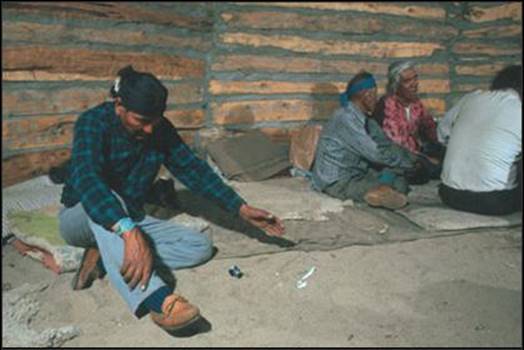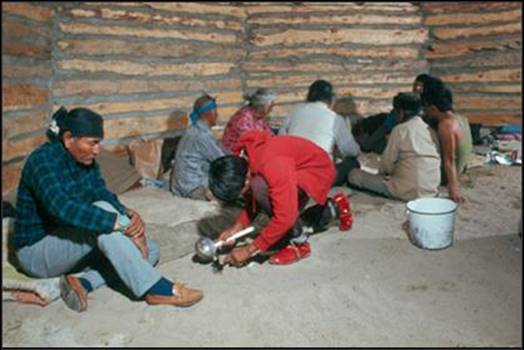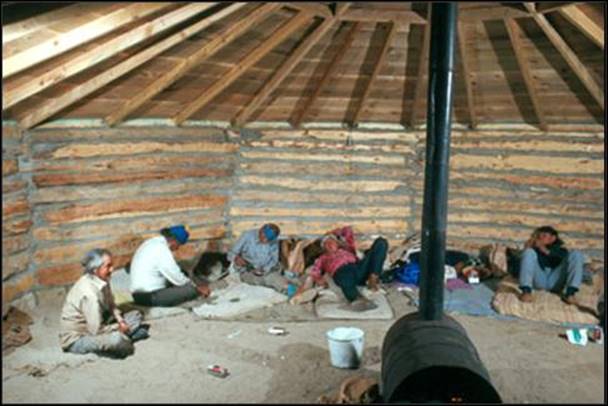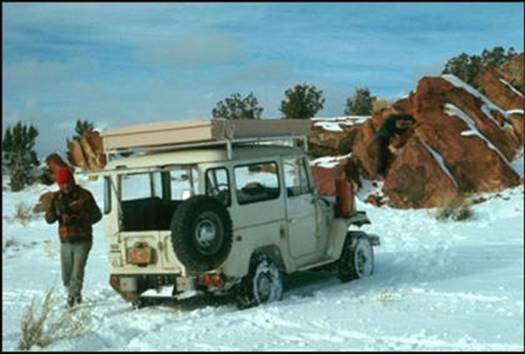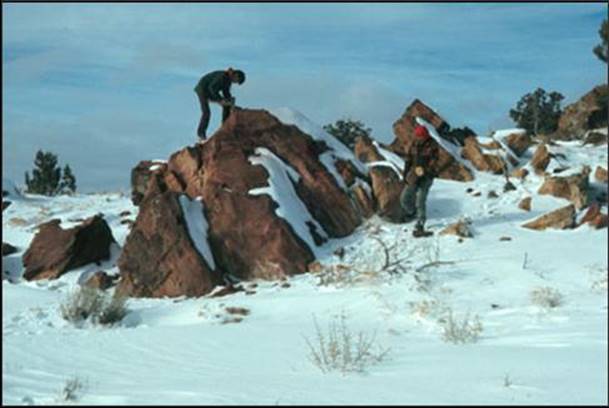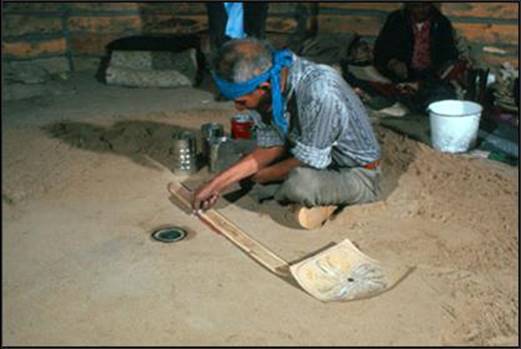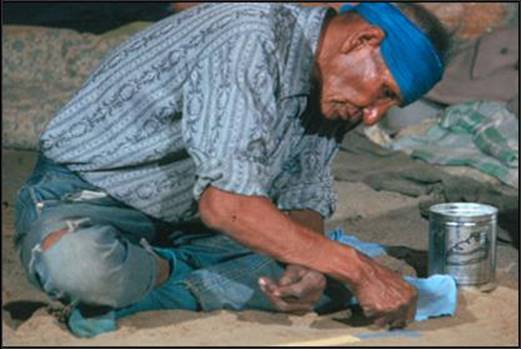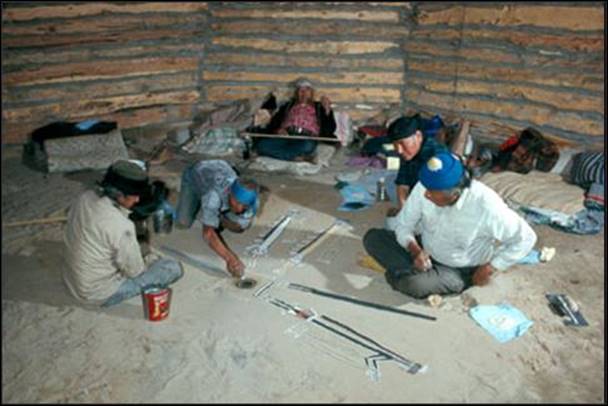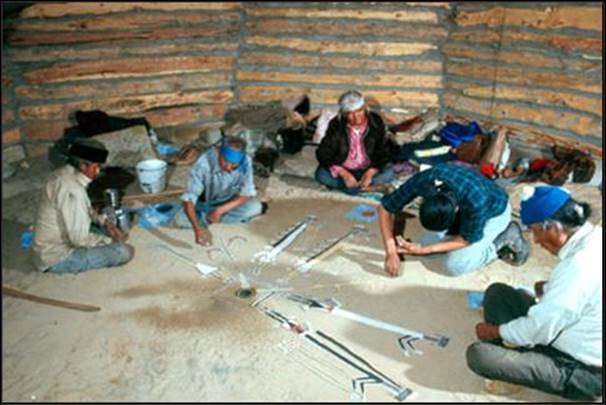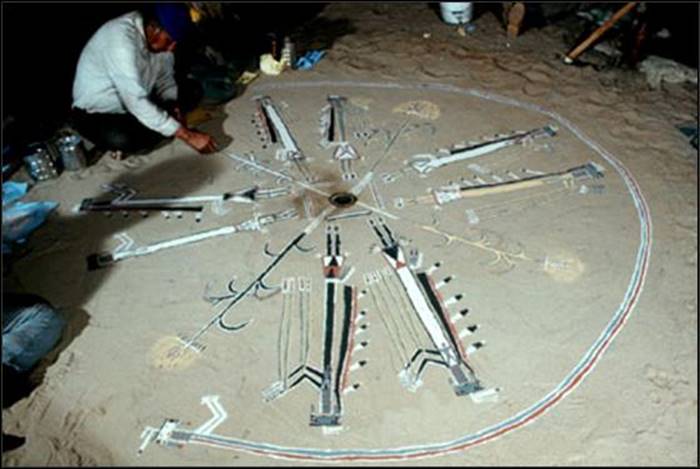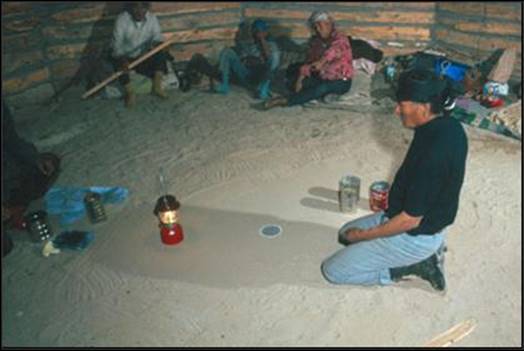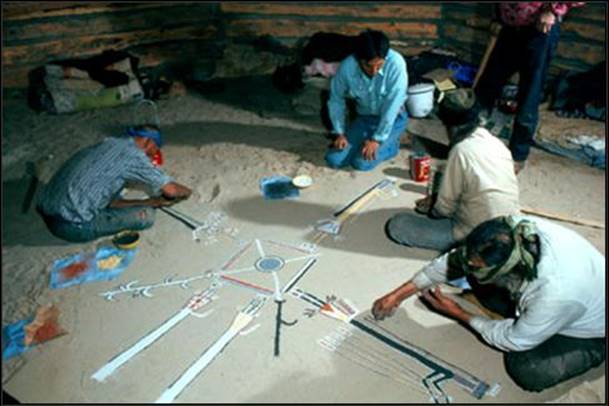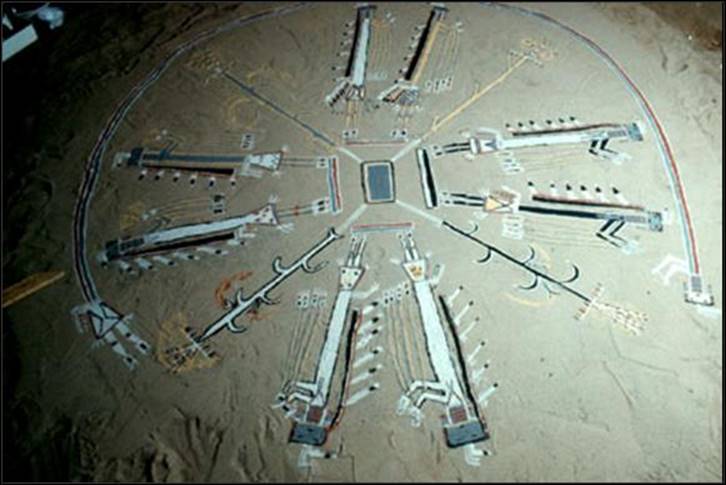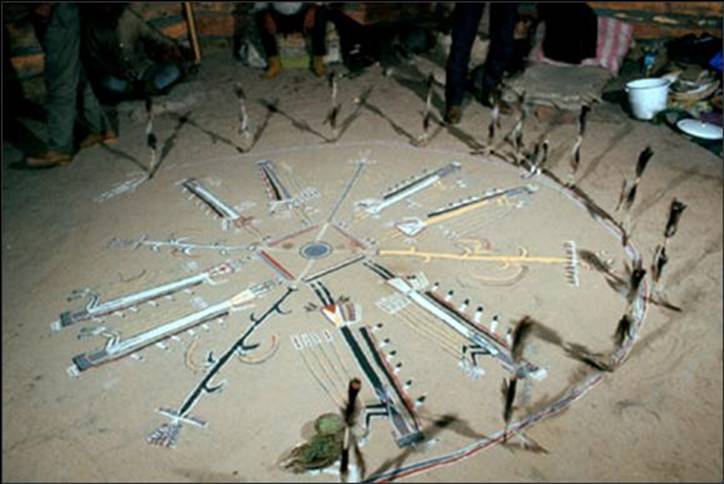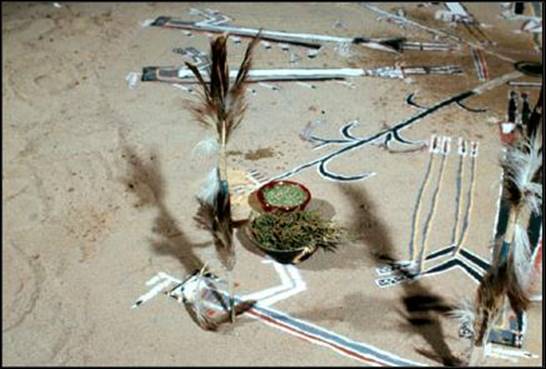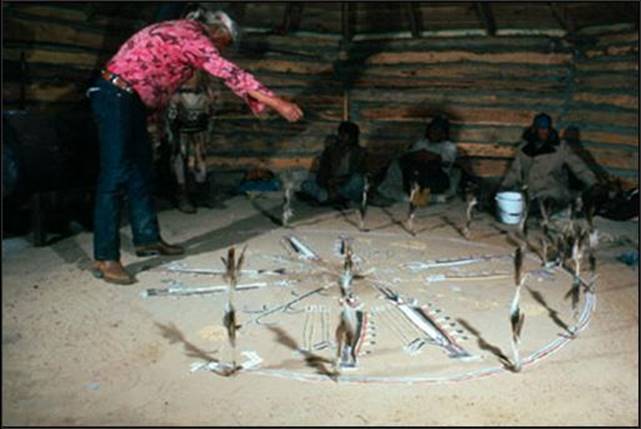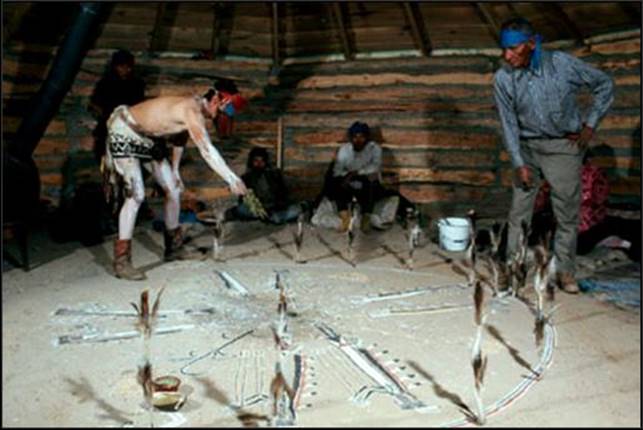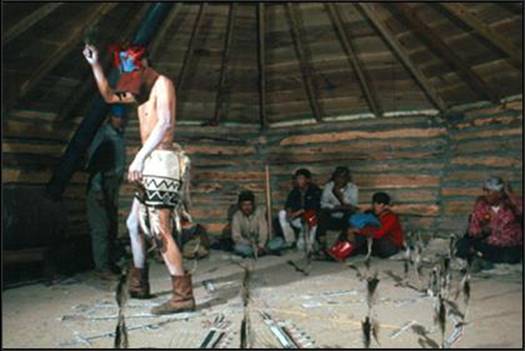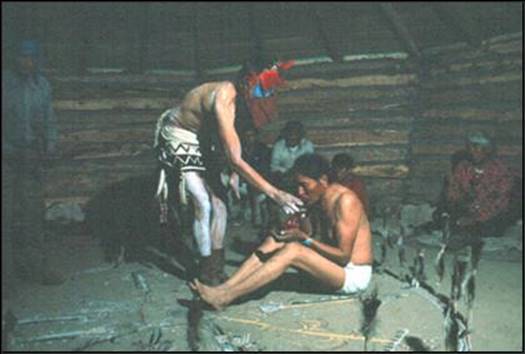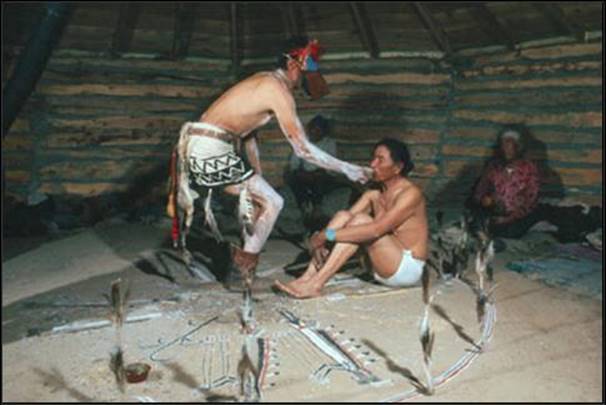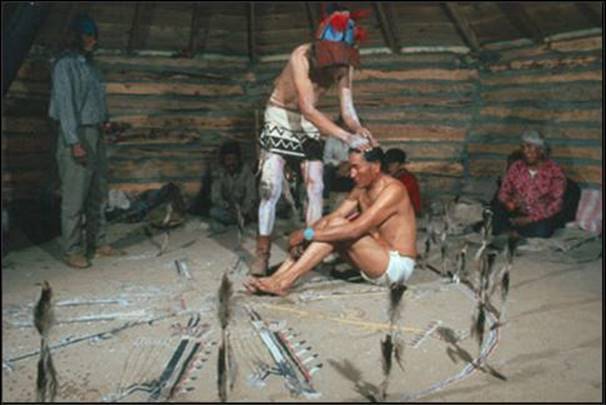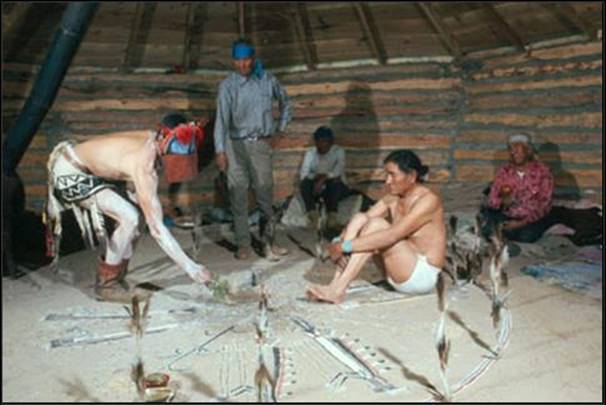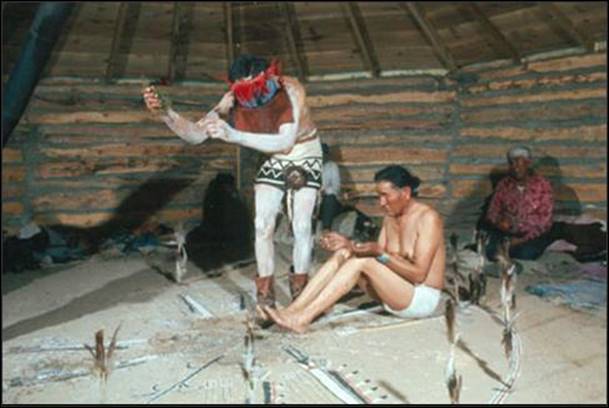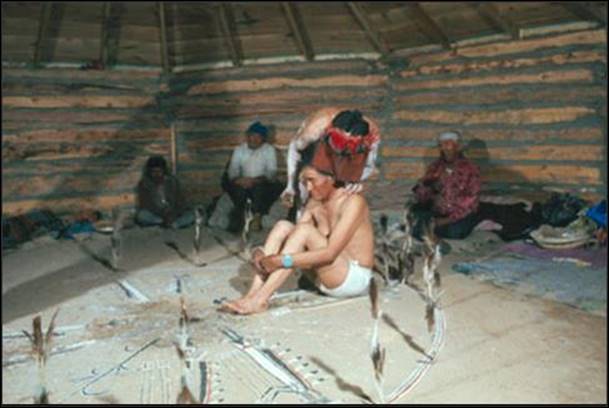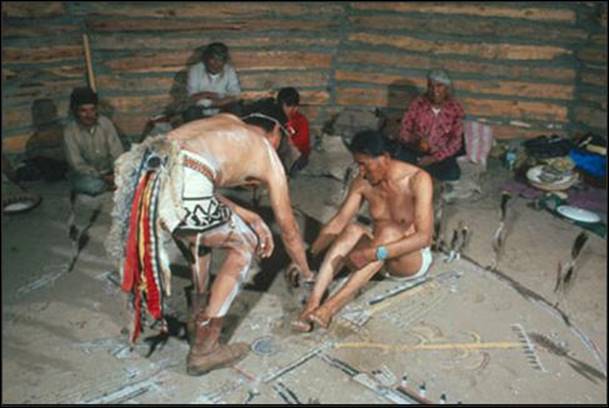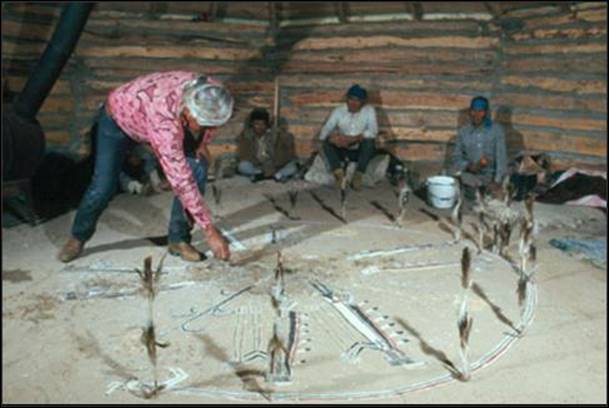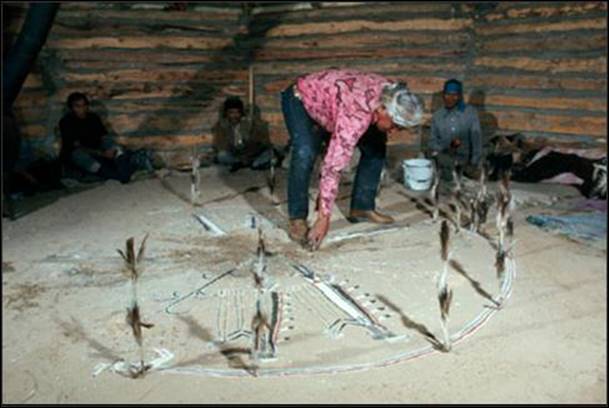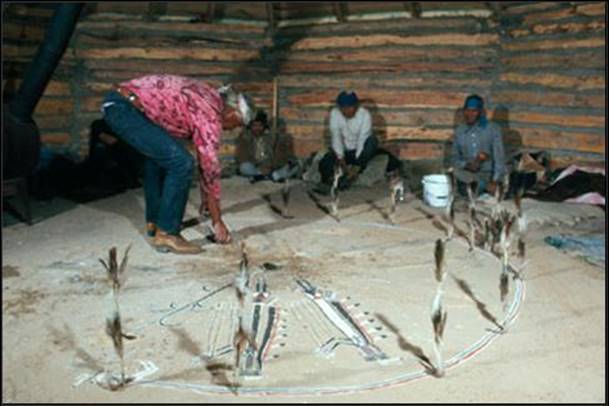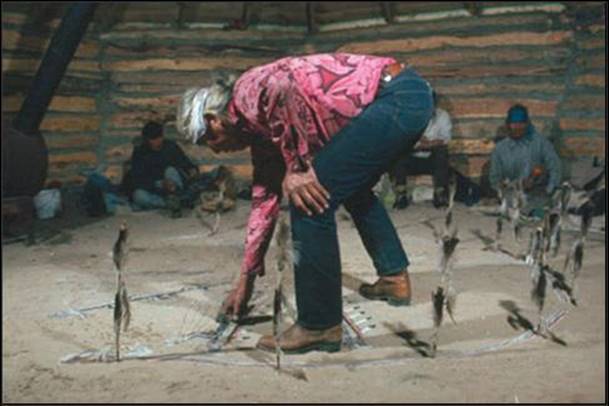COYOTEWAY – Pages 97-158
A Navajo Holyway Healing
Ceremonial
Karl
W. Luckert
and
Johnny C. Cooke, Navajo Interpreter
6
Basket-Drum Ceremonies
PREPARATIONS AND AIM
Songs are chanted to the
accompaniment of a basket-drum from the fifth through the eighth evenings of
the Coyoteway ceremonial. As before, most of these songs refer to the
performance of the first Coyoteway ceremonial and to the archetypal Coyote
People. Coyote has been the first sufferer, the first who was healed by
Coyoteway, and also the first to teach his healing procedures to human
apprentices. Health, well being, and general blessings emanate therefore from
the Coyote People whose presence in the surface world is realized by singing
their own archaic and proven songs.
The
basket-drum songs on the fifth evening actually begin a new type of ceremony
that in each instance climaxes on the next morning in the appearance of a
masked yé'ii-impersonator. For three days in a row a blue-masked
god from the underworld visits the patient. On the last day, as many as
three yé'ii-impersonators appear in answer to the previous night's
basket-drum songs.
Two
large leaves of a yucca plant are knitted together into a drumstick with
slices of yucca leaves. Kernels of maize are wrapped into the drumstick -- one
for each participating member. Before him the practitioner sprinkles a leveled
spot with cornmeal. Then, at that same place a moistened wedding basket is
placed upside down on one side of a blanket. The remaining portion of the
blanket is folded over the basket; the basket-drum is ready for use.
;;;;;Page 98
The
participants sit in a circle around the singer. The patient sits at his regular
place north of the practitioner. While the helpers sing along and take turns
among each other with the rattle, the practitioner beats the drum and leads in
the singing. After the first song the patient goes briefly outside; he reenters
to sit somewhere along the south side of the hogan. This is done to separate
him from the old place with which his illness has become associated. Moreover,
the group of people, chanting blessing songs, form a human shield charged with
divine song power to protect the patient from his former troubles.
FIFTH EVENING
The
following basket-drum songs are chanted in unison on the fifth evening of the
Coyoteway ceremonial;
71. Song, Fifth Evening
This is the Fur, this is the Fur.
On the Tips of the Fur is the White Water.
On the Tips of the Fur is the White Medicine....
This song is the same as Song 10.)
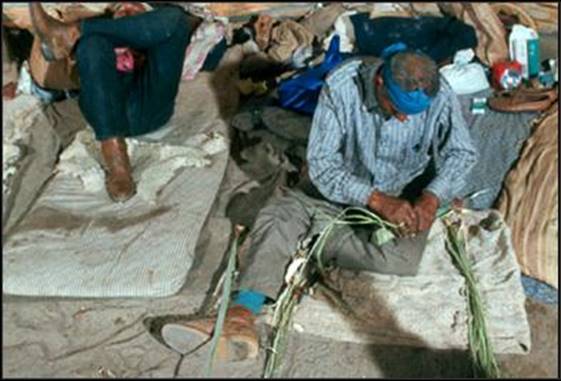
|
|
|
|
;;;;;Page 99
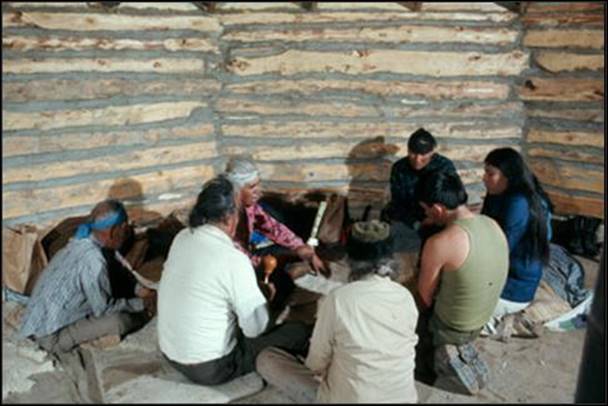 |
|
While the helpers sing
along and take turns among each other with the rattle,
the practitioner
beats the drum and leads in the singing.
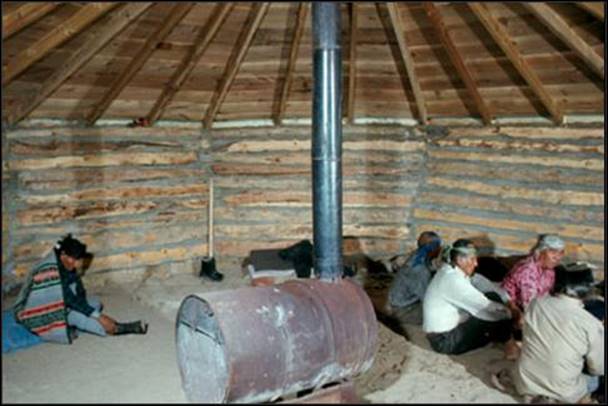 |
|
…the group of people,
chanting blessing songs, form a human shield charged
with divine song
power to protect the patient from his former troubles.
;;;;;Page 100
72. Song, Fifth Evening, similar to Song 25
This is the Hogan, this is the Hogan,
This is the Hogan, this is the Hogan.
This is the Hogan given to me.
This is the White Clay Hogan.
This is the Hogan in the White Fur.
This is the Hogan that is immune.
This is the Hogan given to me.
This is the Hogan, this is the Hogan,
This is the Hogan, this is the Hogan.
This is the Hogan built of Logs.
This is the Hogan in the Mountains
This is the Hogan in the Blue Fur.
This is the Hogan that is immune.
This is the Hogan built of Logs.
This is the Hogan, this is the Hogan,
This is the Hogan, this is the Hogan.
This is the Hogan behind the Hill.
This is the Hogan of the Abalone Shell Lady.
This is the Hogan in the Yellow Fur.
This is the Hogan that is immune.
This is the Hogan behind the Hill.
This is the Hogan, this is the Hogan,
This is the Hogan, this is the Hogan.
This is the Hogan on top of the Mountain.
This is the Brown Hogan on the Mountain.
This is the Hogan in the Black Fur.
This is the Hogan that is immune.
This is the Hogan on top of the Mountain.
This is the Hogan, this is the Hogan,
This is the Hogan, this is the Hogan.
With these he is made well again, with these he is made well
again,
With these he is made well again, with these he is made well
again.
Song
72 is a reduced version of Song 25. It is reduced to four stanzas to
accommodate the four directional colors -- white (east), blue (south), yellow
(west), black (north). Song 72 is repeated three times with sequential variations
-- south, west, north, east; west, north, east, south; and north, east, south,
west.
73. Song, Fifth Evening
With their Blood in me I am immune,
With their Blood in me I am immune,
;;;;;Page 101
With their blood in me I am immune,
With their Blood in me I am immune.
With the Wind People's Blood in me,
With the Cornripener Beetle's Blood in me,
With the White Medicine's Blood in me,
With the Cornripener Sons' Blood in me,
With their Blood in me I am immune.
With the Blue Sky in me,
With the Sons of Blue Sky in me,
With the White Medicine in me,
With their Blood in me I am immune.
With the Yellow Medicine in me,
With the White Medicine in me,
With their Blood in me I am immune,
With their Blood in me I am immune,
With their Blood in me I am immune,
With their Blood in me I am immune.
74. Song, Fifth Evening
Down the Mountain, they roll it over him.
Down the Mountain, they roll it over him.
Down the Mountain, they roll it over him.
Down the Mountain, they roll it over him.
The Rock of Black Cloud's Sons, they roll it over him.
The Rock of White Medicine, they roll it over him.
I am immune, they roll it over him.
It is their Rock, they roll it over him.
The Blue Lizards' Rock, they roll it over him.
At the Place of Yellow Evening, they roll it over him.
The White Medicine's Rock, they roll it over him.
I am immune, they roll it over him.
Down the Mountain, they roll it over him.
Down the Mountain, they roll it over him.
Down the Mountain, they roll it over him.
Down the Mountain, they roll it over him.
Song
74 refers to the episode mentioned in the myth by tséyi'nii (Chapter
10); Coyote came to a place where lizards were sliding down on rocks. He wanted
to slide down with them, but a rock fell on him and smashed him. The song
implies that the lizards rolled a rock over him. According to the myth. Coyote
survived and recovered; this is the important point for the present healing
effort. Together with Coyote, even with rocks crashing on him, the patient is
considered immune.
;;;;;Page 102
The next two songs
elaborate on the Coyote mysticism according to which the patient and the
tenacious Coyote are one.
75. Song, Fifth Evening
He has come back and I am walking,, as I am walking with him,
With his Body I am walking, as I am walking with him.
On the Path I am walking, as I am walking with him.
With his Body I am walking, as I am walking with him.
My Body is immune as I am walking, as I am walking with him.
With the Fur I am walking, as I am walking with him.
My Body is immune as I am walking, as I am walking with him.
In the Woods I am walking, as I am walking with him.
My Body is immune as I am walking, as I am walking with him.
With the Black Fur I am walking, as I am walking with him.
My Body is immune as I am walking, as I am walking with him.
On the Path to Water I am walking, as I am walking with him.
My Body is immune as I am walking, as I am walking with him.
I am not ashamed as I am walking, as I am walking with him.
My Body is immune as I am walking, as I am walking with him.
I am not ashamed as I am walking, as I am walking with him.
76. Song, Fifth Evening
I am not ashamed as I am walking, as I am walking with him.
I am not ashamed as I am walking, as I am walking with him.
I am not ashamed as I am
walking, as I am walking with him.
I am not ashamed as I am
walking, as I am walking with him.
In the White Fur I am walking, as I am walking with him.
The Path behind the Hill I am walking, as I am walking with him.
My Body is immune as I am walking, as I am walking with him.
On the Path to Water I am walking, as I am walking with him.
With the Medicine I am walking, as I am walking with him.
My Body is immune as I am walking, as I am walking with him.
In the Blue Fur I am walking, as I am walking with him.
With the White Corn I am walking, as I am walking with him.
My Body is immune as I am walking, as I am walking with him,...
(continued as in first stanza)
In the Yellow Fur I am walking, as I am walking with him.
The Path behind the Hill I am walking, as I am walking with him.
My Body is immune as I am walking, as I am walking with him.
(continued as in first stanza)
In the Black Fur I am walking, as I am walking with him.
;;;;;Page 103
With the White Corn I am walking, as I am walking with him.
My Body is immune as I am walking, as I
am walking with him....
(continued as in first stanza)
/ am not ashamed as I am walking, as I am walking with
him.
I am not ashamed as I am walking, as I am walking with him.
I am not ashamed as I am walking, as I am walking with him.
I am not ashamed as I am walking, as I am walking with him.
77. Song, Fifth Evening
Hogan below from where he emerges,
Hogan below from where he comes out in a circle,
Hogan below from where he comes out in a circle.
Long Hogan from where he emerges.
Hogan made of White Fur, made in a circle.
Under the Rocks from where he emerges.
My Body is made immune, made in a circle.
Hogan below from where he comes out in a circle,
Hogan below from where he comes out
in a circle.
Long Hogan from where he emerges.
Hogan made of Blue Fur, made in a circle.
(Continued as in first stanza. Third and fourth stanzas are sung
with
Yellow Fur and Black Fur respectively.)
Song
77 presents an interesting, and very logical, mixture of Pueblo Indian emergence
mythology and Apachean hunter wit. The hole of emergence is here a foxhole
(foxes are coyotes) under a rock. The underworld hogan of Coyote is recognized
as a long underground burrow, extending in a circle.
78. Song, Fifth Evening
The Adulterous Coyote, he walks underground.
The Song he sings does not affect me, he walks underground.
In the White Fur, he walks underground.
A Song he sings, as he walks underground.
The Song he sings does not affect me, he walks underground.
He does not see me, as he walks underground.
He sings under a Spruce Tree, as he walks underground.
The Song he sings does not affect me, he walks underground.
The Sunset Twilight Boy, he walks underground.
The Song he sings does not affect me, he walks underground.
He sings under a Spruce Tree, as he walks underground.
The Song he sings does not affect me, he walks underground.
;;;;;Page 104
79. Song, Fifth Evening
The Adulterous Coyote, he calk everywhere, underground.
A Song he sings, he calls everywhere, underground.
The Song he sings does not affect me, he calk everywhere,
underground.
The One Running Along the Path, under the Spruce Tree, he calk
everywhere, underground.
The Song he sings does not affect me, he calk everywhere,
underground.
The One Running Along the Path, under the Spruce Tree, he calk
everywhere, underground.
The Song he sings does not affect me, he calk everywhere,
underground.
The One Running Along the Path, on the Rock, he calls everywhere,
underground.
80. Song, Fifth Evening
He makes the Medicine, he makes the Medicine,
He makes the Medicine, he makes the Medicine,
He makes the Medicine, he makes the Medicine,
He makes the Medicine, he makes the Medicine.
The Adulterous Coyote, he makes the Medicine.
Below the Cliffs, he makes the Medicine.
The White Fur, he makes the Medicine.
The Holy Medicine, he makes the Medicine.
The Making of the Medicine, he makes the Medicine.
Out among the Hills, he makes the Medicine.
The Holy Medicine, he makes the Medicine.
The Crystal Medicine, he makes the Medicine.
The Holy Medicine, he makes the Medicine.
The Making of the Medicine, he makes the Medicine.
81. Song, Fifth Evening
I put it in your mouth, I put it in your mouth,
I put it in your mouth, I put it in your mouth.
The Black Medicine, I put it in your mouth.
The Invisible Medicine, I put it in your mouth.
The White Medicine, I put it in your mouth.
The Holy Medicine, I put it in your mouth.
The Invisible Medicine, I put it in your mouth.
_________________________
(1) Literally "he does everything" -- explained by the
singer as "he calls everywhere."
;;;;;Page 105
The White Corn, I put it in your mouth.
The Yellow Medicine, I put it in your mouth.
The Holy Medicine, I put it in your mouth.
The Invisible Medicine, I put it in your mouth.
The Evening Yellow, I put it in your mouth.
The Blue Medicine, I put it in your mouth.
The Holy Medicine, I put it in your mouth.
The Invisible Medicine, I put it in your mouth.
The Crystal Medicine, I put it in your mouth.
The Holy Medicine, I put it in your mouth.
The Medicine is holy to him.
I put it in your mouth, I put it in your mouth,
I put it in your mouth, I put it in your mouth.
82. Song, Fifth Evening
I put it in your mouth, he is eating it;
for its miraculous power, he is eating it,
for its miraculous power, he is eating it.
The White Medicine, he is eating it.
The Holy Medicine, he is eating it.
Here the Medicine, he is eating it.
The Holy Medicine, he is eating it.
Here the Medicine, he is eating it.
For its miraculous power, he is eating it.
The Crystal Medicine, he is eating it.
The Holy Medicine, he is eating it.
Here the Medicine, he is eating it.
I put it in your mouth, he is eating it:
for its miraculous power, he is eating it,
for its miraculous power, he is eating it.
83. Song, Fifth Evening
The Hawks are going in pairs, the Hawks are going in pairs,
The Hawks are going in pairs, the
Hawks are going in pairs.
Out on the Plains they are going in pairs.
On a Path behind the Ridge they are going in pairs.
(To their feathery arrows) I am immune.
(This stanza is sung four times.)
84. Song, Fifth Evening
The Pairs keep going behind ridges,
The Pairs keep going behind ridges,
;;;;;Page 106
The Pairs keep going behind ridges,
The Pairs keep going behind ridges.
White Coyote Pairs keep going behind ridges.
Black Coyote Pairs keep going behind ridges.
The White Medicine, they are eating it.
The Black Medicine, they are eating it.
I am immune.
The Pairs keep going behind ridges,
The Pairs keep going behind ridges,
The Pairs keep going behind ridges,
The Pairs keep going behind ridges.
Yellow Coyote Pairs keep going behind ridges.
Blue Coyote Pairs keep going behind ridges.
The Yellow Medicine, they are eating it.
The Blue Medicine, they are eating it.
I am immune.
The Pairs keep going behind ridges,
The Pairs keep going behind ridges,
The Pairs keep going behind ridges,
The Pairs keep going behind ridges.
85. Song, Fifth Evening
He carried it away, far away, he carried it away.
He carried it away, far away, he carried it away.
Beneath the Two Rising, he carried it away.
The White Prayerstick in his hand, he (White Coyote) carried it
away.
With Happiness before him, he carried it away.
With Happiness behind him, he carried it away.
He carried it away, far away, he carried it away.
He carried it away, far away, he carried it away.
Beneath the Two Above, he carried it away.
The Blue Prayerstick in his hand, he (Blue Coyote) carried it
away.
With Happiness behind him, he carried it away.
With Happiness before him, he carried it away.
He carried it away, far away, he carried it away.
He carried it away, far away, he carried it away.
Beneath the Two Setting, he carried it away.
The Yellow Prayerstick in his hand,
he (Yellow Coyote) carried it away....
(continued as in first stanza)
He carried it away, far away, he carried it away.
He carried it away, far away, he carried it away.
Beneath Where the Stars Turn, he carried it away.
;;;;;Page 107
The Black Prayerstick in his hand,
he (Black Coyote) carried it away....
(continued as in second stanza)
He carried it away, far away, he carried it away.
He carried it away, far away, he carried it away.
SIXTH EVENING
The
following basket-drum songs are chanted in unison on the sixth evening of the
Coyoteway ceremonial:
89. Song, Sixth Evening
To the Hogan I came, to the Hogan I came,
To the Hogan I came, to the Hogan I came.
Beneath the Two Rising, to the Hogan I came.
To the Hogan of White Coyote, to the Hogan I came.
Round Corn across the Door, to the Hogan I came.
On the Pollen-path I came, to the Hogan I came.
Sunshine over the Door, to the Hogan I came.
To the Holy Hogan, to the Hogan I came.
To the Hogan I came, to the Hogan I came,
To the Hogan I came, to the Hogan I came.
Beneath the Two Above, to the Hogan 1 came.
To the Hogan of Blue Coyote, to the Hogan I came.
(continued as in first stanza)
To the Hogan I came, to the Hogan I came,
To the Hogan I came, to the Hogan I came.
Beneath the Two Setting, to the Hogan I came.
To the Hogan of the Yellow Coyote, to the Hogan I came.
(continued as in first stanza)
To the Hogan I came, to the Hogan I came,
To the Hogan I came, to the Hogan I came.
Beneath Where the Stars Turn, to the Hogan I came.
To the Hogan of the Black Coyote, to the Hogan I came.
(continued as in first stanza)
To the Hogan I came, to the Hogan I came,
To the Hogan I came, to the Hogan I came.
Referring
again to all the four directions, this song is repeated three times. The second
round is sung by way of beginning with south (Beneath the Two) and with Blue Coyote.
The third round begins with west (Beneath the Two Setting) and the Yellow
Coyote. The fourth round begins with north (Where the Stars Turn) and ends with
west.
;;;;;Page 108
90. Song, Sixth Evening
It is I, it is I walking!
It is I, it is I walking!
It is I, it is I walking!
It is I, it is I walking!
The White Corn Boy, it is I walking....
(This song is the same as Song 69.)
91. Song, Sixth Evening
I caught up with him, I caught up with him,
I caught up with him, I caught up with him.
Beneath the Two Rising, I caught up with him.
(White Coyote) With the White Prayerstick in his hand,
I caught up with him.
With Happiness before me, I caught up with him.
With Happiness behind me, I caught up with him.
I caught up with him, I caught up with him,
I caught up with him, I caught up with him.
Beneath the Two Above, I caught up with him.
(Blue Coyote) With the Blue Prayerstick in his hand,
I caught up with him.
With Happiness behind me, I caught up with him.
With Happiness before me, I caught up with him.
I caught up with him, I caught up with him,
I caught up with him, I caught up with him.
Beneath the Two Setting, I caught up with him.
(Yellow Coyote) With the Yellow Prayerstick in his hand....
(continued as in first stanza)
Beneath Where the Stars Turn, I caught up with him.
(Black Coyote) With the Black Prayerstick in his hand....
(continues as in second stanza)
This
song is repeated three times in the same manner as Song 89 -- beginning with
south, then with west, and finally with north.
92. Song, Sixth Evening
He gives the Prayerstick to me, he gives the Prayerstick to me,
He gives the Prayerstick to me, he gives the Prayerstick to me.
Beneath the Two Rising, he gives the Prayerstick to me.
White Coyote, White Prayerstick in hand, he gives the Prayerstick
to me.
Happiness before me, he gives the Prayerstick to me.
;;;;;Page 109
Happiness behind me, he gives the Prayerstick to me.
He gives the Prayerstick to me, he gives the Prayerstick to me,
He gives the Prayerstick to me, he gives the Prayerstick to me.
Beneath the Two Above, he gives the Prayerstick to me.
Blue Coyote, Blue Prayerstick in hand, he gives the Prayerstick to
me.
Happiness behind me, he gives the Prayerstick to me.
Happiness before me, he gives the Prayerstick to me.
He gives the Prayerstick to me, he gives the Prayerstick to me,
He gives the Prayerstick to me, he gives the Prayerstick to me.
Beneath the Two Setting, he gives the Prayerstick to me.
Yellow Coyote, Yellow Prayerstick in hand....
(continued as in first stanza)
Beneath Where the Stars Turn, he gives the Prayerstick to me.
Black Coyote, Black Prayerstick in hand....
(continued as in second stanza)
This
song is repeated three times in the same manner as Song 89 -- beginning with
south, then with west, and finally with north.
93. Song, Sixth Evening
He came back with me, he came back with me,
He came back with me, he came back with me.
From Beneath the Two Rising, he came back with me.
The White Coyote, he came back with me.
With Happiness before me, he came back with me.
With Happiness behind me, he came back with me.
He came back with me, he came back with me,
He came back with me, he came back with me.
From Beneath the Two Above....
(continued with "Blue Coyote" and "Happiness
behind")
From Beneath the Two Setting....
(continued with "Yellow Coyote" and "Happiness
before")
From Beneath Where the Stars Turn....
(continued with
"Black Coyote" and "Happiness behind")
This
song is repeated three times in the same manner as Song 89 -- beginning with south,
then with west, and finally with north.
94. Song, Sixth Evening
They are now sitting by me, they are now sitting by me,
They are now sitting by me, they are now sitting by me.
;;;;;Page 110
From Beneath the Two Rising, they are now sitting by me.
The White Coyote People, they are now sitting by me.
With Happiness before me, they are now sitting by me.
With Happiness behind me, they are now sitting by me.
They are now sitting by me, they are now
sitting by me,
They are now sitting by me, they are now
sitting by me.
From Beneath the Two Above....
(continued
with "Blue Coyote" and "Happiness behind")
From Beneath the Two Setting....
(continued
with "Yellow Coyote" and "Happiness before")
From Beneath Where the Stars Turn....
(continued
with "Black Coyote" and "Happiness behind")
This
song is repeated three times in the same manner as Song 89 -- beginning with
south, then with west, and finally with north.
SEVENTH EVENING
The
following basket-drum songs are chanted in unison on the seventh evening of the
Coyoteway ceremonial:
98. Song, Seventh Evening
This is the Hogan, this is the Hogan,
This is the Hogan, this is the Hogan.
This is the Hogan given to me....
(This song is the same as Song 72.)
99. Song, Seventh Evening
The One walking in the fields, the Boy, is found.
Beneath the Two Rising, he is found.
Over the White Mountain, he is found.
With White Corn around him, he is found.
Over the Path of Cornpollen, he is found.
Over Morning Twilight, he is found.
With Round Corn around him, he is found.
He is my Relative, he is found.
He is my Relative, he is found.
He is my Relative, he is found.
He is my Relative, he is found.
The One walking in the fields, the Girl, is found.
Beneath the Two Setting, she is found.
Over the Yellow Mountain, she is found.
With Yellow Corn around her, she is found.
;;;;;Page 111
Over the Path of Cornpollen, she is found.
Over Evening Twilight, she is found.
With Round Corn around her, she is found.
She is my Relative, she is found.
She is my Relative, she is found.
She is my Relative, she is found.
She is my Relative, she is found.
The One walking in the fields, the Boy, is found.
Beneath the Two Above, he is found.
Over the Blue Mountain, he is found.
With Blue Corn around him, he is found.
Over the Path of Cornpollen, he is found.
Over the Roots of Sunlight, he is found.
With Round Corn around him, he is found.
He is my Relative, he is found.
He is my Relative, he is found.
He is my Relative, he is found.
He is my Relative, he is found.
The One walking in the fields, the Girl, is found.
Beneath Where the Stars Turn, she is found.
Over Black Mountain, she is found.
With Black Corn around her, she is found.
Over the Path of Cornpollen, she is found.
Over the Roots of Rain, she is found.
With Round Corn around her, she is found.
She is my Relative, she is found.
She is my Relative, she is found.
She is my Relative, she is found.
She is my Relative, she is found.
This is the Hogan, this is the Hogan,
This is the Hogan, this is the Hogan.
This
song is chanted four times in the same directional sequence. The Boys in the
east and south, and the Girls in the west and north, are Coyotes.
200. Song, Seventh Evening
From far away, he comes out.
From far away, he comes out.
From far away, he comes out.
From far away, he comes out.
From under the Two Rising, he comes out.
From the Hogan, in white fur, he comes out.
;;;;;Page 112
Far away from this Hogan, he comes out.
With Happiness before him, he comes out.
With Happiness behind him, he comes out.
From far away, he comes out.
From far away, he comes out.
From far away, he comes out.
From far away, he comes out.
From under the Two Setting, he comes out.
From the Hogan, in yellow fur, he comes out.
Far away from this Hogan, he comes out.
With Happiness behind him, he comes out.
With Happiness before him, he comes out.
From far away, he comes out.
From far away, he comes out.
From far away, he comes out.
From far away, he comes out.
From under the Two Above, he comes out.
From the Hogan, in blue fur, he comes out....
(continued as in first stanza)
From beneath Where the Stars Turn, he comes out.
From the Hogan, in the black fur, he comes out....
(continued as in second stanza)
This
song is chanted four times in the same directional sequence. The phrases
"in white fur -- or yellow, blue, and black fur" are ambiguous. They
may define the emerging Coyote-persons, the hogans from where they emerge, or
both.
EIGHTH EVENING
The
following basket-drum songs are chanted in unison on the eighth evening of the
Coyoteway ceremonial:
104. Song, Eighth Evening
With my Mind I walk in the presence of the Sun,(2)
with my Mind I walk, with my Mind I walk,
with my Mind I walk, with my Mind I walk.
Beneath the Two Rising, with my Mind I walk.
Where White Coyote Medicine is, with my Mind I walk.
Where White Air is, with my Mind I walk.
___________________________________
(2) With my Mind I walk." or, "In proximity of my Mind
(Consciousness) I walk." The mind of the patient is here regarded as an
independent personage.
;;;;;Page 113
On the Path of yellow Cornpollen, with my Mind I walk.
Among Rainbows, with my Mind I walk.
Amid round Corn, with my Mind I walk, with my Mind I walk.
Beneath the Two Setting, with my Mind I walk.
Where Yellow Coyote Medicine is, with my Mind I walk.
Where Yellow Air is, with my Mind I walk.
On the Path of yellow Cornpollen, with my Mind I walk.
In Sunshine, with my Mind I walk.
Amid round Corn, with my Mind I walk, with my Mind I walk.
Beneath the Two Above, with my Mind I walk.
Where Blue Coyote Medicine is, with my Mind I walk.
Where Blue Air is, with my Mind I walk.
On the Path of yellow Cornpollen, with my Mind I
walk.
In Sunshine, with my Mind I walk.
Amid round Corn, with my Mind I walk, with my Mind I walk.
Beneath Where the Stars Turn, with my Mind I walk.
Where Black Coyote Medicine is, with my Mind I walk.
In the Black Mountains, with my Mind I walk.
On the Path of yellow Cornpollen, with my Mind I
walk.
Among the Roots (Streaks) of Rain, with my Mind I walk.
Amid round Corn, with my Mind I walk, with my Mind I walk.
With my Mind I walk in the presence of the Sun,
With my Mind I walk, with my Mind I walk,
With my Mind I walk, with my Mind I walk.
105. Song, Eighth Evening
I am looking for my Mind in the presence of the Sun3
I am looking for my Mind, I am looking for my Mind,
I am looking for my Mind, I am looking for my Mind.
Beneath the Two Rising, I am looking for my Mind....
(continued after the pattern of Song 104)
106. Song, Eighth Evening
I have found my Mind in the presence of the Sun4
I have found my Mind, I have found my Mind,
I have found my Mind, I have found my Mind.
Beneath the Two Rising, I have found my Mind....
(continued after the pattern of Song 104)
_______________________
(3) "I am looking for my Mind," or, "I am
struggling for Consciousness."
(4) "I have found my Mind,"
or, "I am beginning to perceive."
;;;;;Page 114
107. Song, Eighth Evening
I am bringing back my Mind in the presence of the Sun,(5)
I am bringing back
my Mind, I am bringing back my Mind,
I am bringing back my Mind, I am
bringing back my Mind.
Beneath the Two Rising, I am bringing back my Mind....
(continued after the pattern of Song 104)
108. Song, Eighth Evening
I am reviving my Mind in the presence of the Sun, (6)
I am reviving my Mind, I am reviving
my Mind,
I am reviving my Mind, I am reviving
my Mind.
Beneath the Two Rising, I am reviving my Mind..,.
(continued after the pattern of Song 104)
109. Song, Eighth Evening
Now my Mind is walking with me in the presence of the Sun,(7)
now my Mind is walking with me, now my Mind is walking with me,
now my Mind is walking with me, now my Mind is walking with
me.
Beneath the Two Rising, now my Mind is walking with me....
(continued
after the pattern of Song 104)
110. Song, Eighth Evening
Now my Mind is remade for me in the presence of the Sun,(8)
now my Mind is
remade for me, now my Mind is remade for me,
now my Mind is remade for me, now my Mind
is remade for me.
Beneath the Two Rising, now my Mind is remade for me....
(continued after the pattern of Song 104)
111. Song, Eighth Evening
Now my Mind returns with me in the presence of the Sun, (9)
now my Mind returns
with me, now my Mind returns with me,
now my Mind returns with me, now my
Mind returns with me.
Beneath the Two Rising, now my Mind returns with me....
(continued after the pattern of Song 104)
______________________________
(5) "I am bringing back my Mind," or, "I am
regaining Consciousness."
(6)"I am reviving my Mind"
-- as one would teach a baby to walk.
(7) "Now my Mind is walking with
me" -- it has learned to go on its own power.
(8) "Now my Mind is remade for
me," or, "we are together again."
(9) Now my Mind returns with
me," or. "now I am starting back with my Mind, side by side."
Mind and body function together.
;;;;;Page 115
112. Song, Eighth Evening
Now I am sitting with my Mind in the presence of the Sun, (10)
now I am sitting with my Mind, now I am sitting with my Mind,
now I am sitting with my Mind, now I am sitting with my Mind.
Beneath the Two Rising, now I am sitting with my Mind....
(continued after the pattern of Song 104)
113. Song, Eighth Evening
With Black Bead as my feet, with this I walk.
Clothed in Black Coyote, with this I walk.
Clothed in Black Water, with this I walk.
Clothed in Arrows, with this I walk.
He (Coyote) is hiding behind me, with him I walk.
He is hiding before me, with him I walk.
With these, with these, everything is made Happiness.
With these, with these, everything is made Happiness.
With these everything is made Happiness.
With these everything is made Happiness.
With these. Happiness behind me.
With these. Happiness before me.
With these, with these, everything is made Happiness.
With these, with these, everything is made Happiness.
With Turquoise as my feet, with this I walk.
Clothed in Blue Coyote, with this I walk.
In the Place of Rainbow, there I walk.
In Rain behind the Rainbow, there I walk.
Among ripe Plants behind the Rain, there I walk.
With Roots of Sunshine, with these I walk.
Healing Power behind these, with this I walk.
With these, with these, everything is made Happiness....
(continued
as in first stanza)
114. Song, Eighth Evening
They are singing for me, they are singing for me,
They are singing for me, they are singing
for me.
The Talking-god's Son I am, they are singing for me.
Where White Bead points down, they are singing for me.
Clothed in Black Air, they are singing for me.
Surrounded by Black Lightning, they are singing for me.
_________________________________
(10) Now I am sitting with my mind" -- side by side in the
hogan. Consciousness and well-being are present as the patient sits in
the hogan.
;;;;;Page 116
With Happiness before me, they are singing for me.
Traveling on the Roots of Morning Dawn, they are singing for me.
With these, with these, everything is made Happiness....
(same
refrain as in Song 113)
The Calling-god's Son I am, they are singing for me.
Where the Turquoise points down, they are singing for me.
Clothed in Blue Cornripener Beetles, they are singing for me.
In the Place of Rainbow, they are singing for me.
In Rain behind the Rainbow, they are singing for me.
Among ripe Plants behind the Rain, they are singing for me.
At the Roots of Sunshine, with these I walk.
Healing Power behind these, with this I walk.
With these, with these, everything is made Happiness....
(same
refrain as in Song 113)
115. Song, Eighth Evening
It is raining on me, it is raining on me,
It is raining on me, it is raining on me.
The Talking-god's Son I am, it is raining on me.
With White Bead as my shoes, it is raining on us.
Where White Bead points down, it is raining on us.
Clothed in Black Cornripener Beetles, it is raining on us.
Clothed in Black Water, it is raining on us.
Clothed in Black Cloud, it is raining on us.
In the Place of Rainbow, it is raining on us.
In Rain behind the Rainbow, it is raining on us.
Among ripe Plants behind the Rain, it is raining on us.
At the Roots of Morning Dawn, it is raining on us.
With these, with these, everything is made Happiness....
(same
refrain as in Song 113)
The Calling-god's Son I am, it is raining on me.
Where the Turquoise points down, it is raining on us.
Clothed in the Blue Prayerstick, it is raining on us.
Clothed in Blue Sky, it is raining on us.
In the Place of Rainbow, it is raining on us.
In Rain behind the Rainbow, it is raining on us.
Among ripe Plants behind the Rain, it is raining on us.
At the Roots of Sunshine, it is raining on us.
Healing Power behind these, it is raining on us.
With these, with these, everything is made Happiness....
(same
refrain as in Song 113)
;;;;;Page 117
116. Song, Eighth Evening
The blessing is given, the blessing is given,
The blessing is given, the blessing is given.
The Talking-god's Son I am, the blessing is given.
Where White Bead points down, the blessing is given.
Clothed in the Black Prayerstick, the blessing is given.
Clothed in Black Cloud, the blessing is given.
In the Place of Rainbow, the blessing is given.
In the Place of Ripened Plants, the blessing is given.
In the Place of Rain, the blessing is given.
At the Roots of Morning Dawn, the blessing is given.
With Rain behind me, the blessing is given.
With Healing Power before the Rain, the blessing is given.
With these, with these, everything is made Happiness...
(same
refrain as in Song 113)
The Calling-god's Son I am, the blessing is given.
Where Turquoise points down, the blessing is given.
Clothed in Blue Cornripener Beetles, the blessing is given.
Clothed in the Black Prayerstick, the blessing is given.
With Rain behind me, the blessing is given.
Among ripe Plants behind the Rain, the blessing is given.
At the Roots of Sunshine, the blessing is given.
With Healing Power following these, the blessing is given.
With these, with these, everything is made Happiness...
(same
refrain as in Song 113)
;;;;;Page 118
BURNING THE FEATHERS
Each session of
basket-drum singing ends with a Feather-burning Rite -- the same procedure
which earlier has been described in connection with the Unraveling and the
Fire Ceremonies. As was the case then, a feather mixture is sprinkled on a hot
coal, the smoke is fanned and rubbed on the patient, then the coal is quenched
with water. The extinguished coal, which has absorbed many of the patient's
troubles, is carried away while he is temporarily outside. When the patient
returns he sits again at his regular place. The priestly singer sprinkles
cornmeal in the four directions and explains in a subdued voice that the act of
burning and removing the feathers is not sufficient by itself. The positive
blessings of sacred meal, power of life, must be added to heal the wounds left
behind by the exorcised feathery witchcraft arrows.
After
each ceremony follows a period of rest. Whoever feels so inclined, is free to
play a game of cards.
|
|
...a feather mixture
is sprinkled on a hot coal, the smoke is
fanned and
rubbed on the patient...
;;;;;Page 119
|
|
…then the coal is
quenched with water.
;;;;;Page 120
|
|
After each ceremony follows
a period of rest.
Whoever feels so
inclined is free to play a game of cards.
7
Sandpainting
Ceremonies
The Problem of Naming the Yé'ii
The Navajo language has
three names to refer to the gods -- yé'ii, hashch'ééh, diné dighinii. In
usage these names overlap quite easily. Some yé'ii are hashch'ééh, and
some hashch'ééh are diné dighinii (Holy
People). The name yé'ii is mostly reserved for those gods who appear
in ceremonials in the form of masked human impersonators.
On
the fifth, sixth, and seventh mornings of the Coyoteway ceremonial, during the
sandpainting ceremonies, a masked yé'ii- impersonator appears.
What is the name of the god whom he impersonates? This question is directly
linked to the identity of three other yé'ii figures who appear
on the eighth morning. The second figure of this group is identical with the
single yé'ii of the three preceding days. Our discussion may
therefore focus on the identities of the entire triad.
The
name of the first yé'ii figure on that culminating eighth
morning is beyond doubt. He is the yé'iibicheii, grandfather
and leader of all the Navajo gods. As an authentic hunter deity he wears a buckskin
over his shoulders and carries a fawn skin pouch. In the middle of his face,
however, is painted the mark of Pueblo Indian influence -- a maize plant.
Impersonated by a man, he appears on the eighth morning to bless the patient,
the other yé'ii-impersonators, and the sandpainting. As an outward
symbol of his blessings he sprinkles pollen.
The
second yé'ii in our Coyoteway ceremonial is also impersonated
by a man. His blue mask and his apparel are identical with those of the
;;;;;Page 122
yé'ii figure of the
preceding three sandpainting ceremonies. When he appears together with the
other two gods on the eighth day, his actions match those of the preceding days
-- despite the fact that on the last day, in our ceremonial, a different man
played the role. The only added function on the eighth day involves his
carrying a stuffed Blue Coyote (gray fox). His overall appearance and costume
correspond to those of the anthropomorphic lead figures in the sandpainting of
the same day.
The
third yé'ii is impersonated by a woman. She wears a blue mask,
identical to that of the second yé'ii. While her male
counterpart carries a stuffed Coyote, she carries a basket containing ears of
maize, with eagle tail feathers radiating from it. The same basket can be found
depicted in the hands of all the anthropomorphic follower-yé'ii in
the sandpainting of the eighth day. Both the second and the third yé'ii-impersonators
are thus, via stuffed animal and basket, clearly identical with the yé'ii figures
in the fourth sandpainting. On this point all the participants agree.
Of
the two blue-masked figures the third in the triad is easiest to name. All our
participants, and all the written sources, agree that she is hashch'ééh
bi'áád, the Female God. Luke Cook identified her more precisely as a
daughter of the Talking-god. Man With Palomino Horse referred to her as
Talking-god's Female.
This
leaves only the problem concerning the identity of the second yé'ii-impersonator.
And here we must divide the information we have with regard to specific
informants and sources. Luke Cook, who interpreted all yé'ii figures
in the sandpaintings as anthropomorphic Coyote People, consistently identified
the second yé'ii-impersonator with Coyote-carrying Coyotes in the
underworld. The blue mask, and the stuffed "blue fox" in his hands,
links this deity with the south. Accordingly, the second yé'ii is
Blue Coyote from the underworld's south. On three successive days he appears in
the microcosm of the sandpainting without his animal manifestation. On the last
day he is depicted in the sandpainting in both his human and his animal forms.
He appears impersonated, each day exactly as the sandpainters have portrayed
and invited him in their sandpainting. If this interpretation is carried to its
logical conclusion, then the third yé'ii-impersonator is not merely
a Female God, but Blue Coyote Woman from the underworld's south.
However,
Man With Palomino Horse understands his work a little differently. The yé'ii figures
in the sandpaintings represent simply anthropomorphic gods -- not necessarily
anthropomorphic Coyote People. The god-impersonators who appear in the
sandpainting ceremonies are simply yé'ii, nothing more. The
second figure in the triad just happens to be the yé'ii who
carries Coyote. He is a god who by way
;;;;;Page 123
of the stuffed gray fox
"makes use of" Coyote as one would make use of a tool. In answer to
my direct question about the gender of the second and third impersonators, our
Coyoteway singer produced some rather puzzling news: both are Female Gods. I am
convinced that every reader who examines the photographic evidence will agree
with me that the second yé'ii is impersonated by a male.
Seeing my disbelief clearly written on my face, the singer struggled for a more
congenial answer: the first is the Talking-god, the second is the Calling-god,
and the third is the Female Cod. This made sense. A blue-masked yé'ii belongs
to the south, and Calling-god is indeed the best candidate for claiming this
mask. Talking-god and Calling-god frequently appear together. All seems to be
well with this last emphatic explanation by the practitioner -- except that the
known masks of Calling-god in the Navajo repertoire do not match the mask of
our second yé'ii. If the masks that are used in the most
elaborate "yé'iibicheii ceremonial," the Night
Chant, can be used for comparison, then the mask of our second impersonator is
indeed that of a female deity.
It
is doubtful whether our Coyoteway singer will ever be able to come forth with
more definite explanations. His yé'ii figures, whether male or
female, have no precise counterparts in the Coyoteway myth as he knows it.
Rather, it seems that for him the yé'ii-impersonations are
additions to the ceremonial procedures; also, it seems that they are dictated
more by tradition or by competition with other "yé'iibicheii" ceremonials
than by rational necessity. Moreover, his reduction of the animal
manifestations of Coyote to the level of tools is in disagreement with the
Coyote mysticism expressed throughout the ceremonial in rituals and songs. It
appears that our priest has projected into his present answers his own latent
ambitions for taking control. To some extent, by performing Coyoteway, he
himself has begun using Coyote as a tool. This portrait of the singer may well
be exaggerated. Nevertheless, his patient, who was about to be initiated as a
novice, still experienced the presence of Coyote mystically, after the manner
of shamanic possession by some greater-than-human divine being. Luke Cook has
been participating in Coyoteway ceremonials too long for having his
understanding of them taken lightly.
By
surveying the literary sources one gets the impression that perhaps in
Coyoteway, at least since the time when it was being performed with
sandpaintings and with yé'ii-impersonators, the ambiguity about
its divine actors has always been present. Father Berard Haile (1947, p. 39)
voiced the same complaint even with regard to the better-known yé'ii figures
of the Nightway ceremonial. Thus, if we should ask our Coyoteway singer again
whether the second impersonator always wore the same type of mask, we can
easily predict his
;;;;;Page 124
answer.
Whether he knows better or not, he would have to answer yes. As long as he
performs the ceremonial he will have to claim that everything he does is true
to tradition and to the original instructions of the gods.
Before
leaving the identity of the second yé'ii in the triad for the
reader to decide, we must consult the written sources. They are scarce indeed.
In 1910 the Franciscan Fathers wrote in their Ethnologic Dictionary (p.
392): "In the Coyote dance, which is now extinct, three personators of
Talking-god, the Fringed Mouth, and a Female God appeared. It is said that the
Fringed Mouth danced carrying a live kit-fox in his hands. This was done inside
the hogan." Father Berard Haile (1947, p. 65) tells us that in the
Nightway ceremonial the Fringed Mouth is named after "a fluff of blue
fox" which encircles his mouth.
In
the same report Father Berard also identifies the yé'ii-persons of
the Coyoteway ceremonial (p. 77): On the last day of the ceremonial three yé'ii appear,
Talking-god and two Female Gods. "One of the female yé'ii carries
a mą'ii -- blue fox -- which is prepared with care so that it
resembles a live one. This he applies to the patient to sanctify him. The other
(female) yé'ii carries a basket with cornmeal that he applies
to the patient as in Nightway. In Nightway he (this female yé'ii) carries
a white and yellow ear of corn that he applies to the patient. According to its
legend the three yé'ii (Talking-god and two Female Gods)
appeared at the Coyoteway ceremonial. Hence singers of this chantway own these
masks and do not borrow them from Nightway." Tséyi'nii (1934),
in the second Coyoteway myth reprinted (Chapter 10, paragraph 4), also mentions
two Female Gods in connection with the Talking-god.
Then,
Mary Wheelwright, in 1931, obtained a Coyoteway myth from yoo' hataałii who
had learned it from hastiin neez (reprinted in Chapter 9).
From this version we learn that "on the last night the patient stands on a
buckskin holding ground meal in a basket and three gods, Talking-god, Coyote,
and Female God come to the patient and Female God holds a shell with cornpollen
in it and four eagle tail feathers radiating from the center." This last
portion of information is the more interesting if we consider that our Man
With Palomino Horse derives the sandpainting portion of his ceremonial -- thus
presumably also matters pertaining to yé'ii-impersonations -- from hastiin
neez also.
Thus,
according to our available data, our second yé'ii can be as
many as five different kinds of divine beings: Fringed Mouth, a second Female God,
Coyote, a Female Coyote, or Calling-god. Knowing the context in which the name
of Calling-god was given, I discount this possibility from the outset.
;;;;;Page 125
Fringed
Mouth is a candidate for very early versions of Coyoteway, especially because
the fluff that is present around his mouth comes from the "blue fox."
While this association of the Coyote Carrier with the stuffed gray fox could
have brought Fringed Mouth into the Coyoteway ceremonial at an early date,
another line of explanation appears at least plausible. On the ninth night of
each Nightway ceremonial "Talking-god, Fringed Mouth, and Humpback,
approach the hogan. The patient goes outside to face them and here Fringed
Mouth motions over him from all sides and accompanies these motions with his
call... (this) may be considered the finale of 'sanctification' ceremonies of
Nightway" (Haile 1947, p. 72). A similar such triad of yé'ii -impersonators
may have been adopted by Coyoteway singers at a very early date, but the
reference by the Franciscan Fathers to Fringed Mouth as the second yé'ii in
Coyoteway can also rest on a limited functional parallel. The Coyote Carrier in
the finale of Coyoteway functions in a similar manner as Fringed Mouth in the
finale of Nightway. For interpreting the version of Coyoteway that we have here
at hand, the participation of Fringed Mouth cannot be assumed. No informant now
living mentions him.
We
must puzzle now over the first claim of Man With Palomino Horse, that both our
second and third impersonators represent Female Gods. This claim is supported
from three directions. In the first place, the mask of the second is identical
with the mask of the third. Secondly, Father Berard as quoted above, and
assumedly from a reliable source, tells us that Coyoteway calls for a
Talking-god and two Female God impersonations. Thirdly, tséyi'nii in
his myth, given in Chapter 10, paragraph 4, mentions two Female Gods together
with the Talking-god.
But,
if this is true, why are not both Female Gods impersonated by women? The answer
to this question, too, is illuminated by looking to Nightway practice for
precedents. Washington Matthews (1902, p. 17f) reported the occasional presence
of up to six different Female God impersonators in Nightway. In most cases the
goddesses are impersonated by a boy or a man of low stature. He wears an ornate
skirt around the hips and a belt ornamented with silver from which a fox skin
dangles behind. All this matches our second figure in Coyoteway very well.
Washington Matthews continues with saying, that on the last night of Nightway
the character of Female God is sometimes assumed by women. The female
impersonators are fully clothed in Navajo woman's dress. That Nightway practice
can be taken as prototype for the Coyoteway yé'ii-impersonations
is suggested already by a fact mentioned earlier in the Haile quotation (1947,
p. 77) -- the ears of maize in the basket of our third impersonator in
Coyoteway are a
;;;;;Page 126
recent borrowing from
Nightway. Sufficient information is thus available to accept our singer's first
answer: The second and third impersonations in our ceremonial are both Female
Gods.
Now
only the most difficult question remains to be asked. If both are Female Gods,
to what species of beings do they belong? Are they anthropomorphic gods? Are
they goddesses of the hunt after the fashion of hashch'ééh oołt'oh in
Nightway? Or are they intended to represent Female Coyotes? Navajo gods still
today participate in the mythological stratum of prehuman flux -- they are not
restricted to certain anthropomorphic, theriomorphic, or occupational manifestations;
they can equally well hide and show themselves in the shimmering lights of
dawn, midday, and sunset. Total invisibility is also in their power. Nevertheless,
in a Coyoteway healing ceremonial, where for nine nights the songs of Coyote
People are chanted, the most likely female deities present -- it would seem -- could
be Coyotes.
Whatever
degree of uncertainty about the identities of the yé'ii characters
in our ceremonial the singer communicated to me, it is outweighed by the
impressions that he left on his apprentice. Luke Cook knew that all,
impersonators and sandpainting figures in our ceremonial -- apart from the
Talking-god -- are Coyotes. This state of affairs bestows full credence on some
data which elsewhere has been obtained from a certain "Big Mustache."
Big Mustache is the same as "Many Whiskers," the man whom our
practitioner has identified as his grandfather and teacher. In 1929 this old
Coyoteway singer gave to Laura Armer the same sandpaintings that our singer
received from hastiin neez. Better yet, he identified all his
sandpainting figures as Coyote Girls. (See Chapter 12 -- Sandpainting
Reproductions, Sandpaintings 2 through 5 by Big Mustache.)
The
presence of female masks in the Coyoteway ceremonial is quite reasonable if
credence is given to an episode in the yoo' hataałii and hastiin
neez version of the myth reprinted in Chapter 9. The first Coyoteway
singer who ventured into the underworld has married two Coyote Girls from each
of the four directions -- exactly the number of yé'ii needed
for the sandpaintings. Marriage, in this context, signifies a mystic union
between a shaman and the divine Coyote People from whom he receives his powers.
Marriage implies that the partners are members of the same species. Judged by
their color, our blue-masked and white-painted female Coyotes belong either to
the blue south or to the white east. Our second and third yé'ii-impersonators
are Coyote Girls either from the underworld's east or south!
This
place in the book is suited as well as any for briefly summarizing Coyoteway
theology. How many Coyote gods are there? The
;;;;;Page 127
answer to this question
depends on the context in which the question is asked.
While
Fire Ceremonies are in progress, the singer recognizes twelve Coyote People;
twelve are contacted by way of prayersticks and prayers: four "Shouting
Coyotes," four Coyotes simply identified by their directional colors,
together with Hidden Boy, White Dawn Girl, Flint Hill Boy, and Water Girl.
Later
references, in songs, to the Adulterous Coyote and the Staggering Coyote seem
to have no specific connection with any of the twelve. These names appear to be
designations of Coyote in general. Many morality stories about these Coyotes
are being told today among the Navajos. What our practitioner emphasized
repeatedly, however, is that he is dealing with the same Coyote. The answer
here is that there is only one Coyote. This assertion is supported by inclusion
of his song about the sliding lizards (Song 74) -- an episode usually
attributed to the staggering or trotting Coyote.
There
is still another way of looking at Coyote People numerically. At a meeting when
we discussed with our Coyoteway singer the cause and remedy of Coyote illness,
he flatly pronounced that there are altogether two Coyotes. The bad Coyote
causes illness, the good Coyote heals. A similar dualism is delineated by tséyi'nii in
Chapter 10, paragraphs 3 and 4: bad Coyote People from the lower world cause
illness; the good Coyote People down there provided the Coyoteway healing
ceremonial. There is a slight hint in the ceremonial that Adulterous Coyote is
the same as the Bad One. In Songs 78 and 79 the fact is celebrated that
"the song he sings does not affect me." But then, immediately in Song
80 the same Adulterous Coyote "makes the Medicine." Considering the
debate in my own Hebrew-Christian tradition, about whether the almighty God
causes only good things to happen or whether he is also responsible for what
has come to be attributed to the Devil, I felt that I should not burden Man
With Palomino Horse with redundant questions. Faced with the presence of
overpowering evil, every kind of theist is sooner or later tempted, by the easy
solution of an ethical dualism, to subtract something from the scope of the god
on whom he depends.
Coyoteway
theology is made easier if we return to the simplified world of the sandpainting.
Not twelve Coyotes, or two or one, but eight Coyote Girls are present and
accounted for. The bad Coyote is not mentioned at all in that context -- unless
one should count here the appearance of a Coyote Witch-person in tséyi'nii's Coyoteway
myth (Chapter 10, paragraph 3). The objective of the ceremony is to obtain
health and power to heal. For this purpose the eight Coyote Girls, who through
marriage empowered the first Coyoteway shaman, are
;;;;;Page 128
sufficient. If
additional blessings are needed in the ceremonial from outside the jurisdiction
of the Coyote People, the Talking-god, grandfather and chief of the Navajo
pantheon, guarantees these with his bodily appearance on the eighth morning.
The occasional references in prayer and songs to Calling-god present the latter
as a helper, or possibly as an extension, of the Talking-god.
Significant
is the form and appearance of the Coyote People in the underworld. They are
anthropomorphic beings who dress themselves in Coyote skins only when they are
leaving their homes. I have explained the nature of traditional hunter gods in
relation to "prehuman flux" (Luckert 1975). In the beginning all
"people" were able to exchange their appearances like clothes. When
eventually humankind and many animals became fixed permanently in their present
shapes, the gods remained in a state of prehuman flux. It was therefore not
necessary for the first Coyoteway shaman to learn his ceremonial from
animal-shaped Coyote manifestations; he learned it from their anthropomorphic
and divine prototypes in the underworld. Anthropomorphs can talk. As
manifestations of logos they are quite capable of revealing
their powerful songs and rational instructions for the ceremonial. It is this
same universal human search for the divine logos by which also
the white Talking-god of the east has been discovered as the chief of the
Navajo pantheon. The logic of this development is clear: if the substratum of
human existence is not personal or anthropomorphically intelligible, then what
is man?
In
structure and form Coyoteway differs from Nightway and other ceremonials at
some points. Leland Wyman has informed me that in chantways that he has
attended the sweat-emetic rite has always preceded the offering rite. He also
explained that three additional ritual procedures are standard parts in most
other five and nine-night ceremonials; these are (1) the consecration of the
hogan on the first night before unraveling by applying cornmeal on the roof
beams and by putting oak twigs in the rafters in the four cardinal directions;
(2) setting out plumed wands on a little mound east of the hogan before dawn on
days when sandpaintings are made; and (3) figure painting and token tying on
the last day before the sandpainting rite.
The
first of these procedures, I must admit, could possibly have been overlooked by
me while I was getting my gear ready -- though I doubt this. Then, branches
from various bushes, including yucca leaves for the drumstick, were indeed
stored in the rafters by the door beginning with noontime after the rites on
the third morning. No special purpose was ascribed to this aside from storing
and unthawing for later gear making. The second of these "standard
procedures" was
;;;;;Page 129
perhaps omitted in our
ceremonial because of the deep snow and the blizzard conditions which prevailed
outside. The third of these procedures could have been performed on the last
day inside the hogan while I was recording from the outside. This seems very
unlikely, though, because the patient has told us repeatedly what went on
inside and what he remembered to have been the complete ritual sequence.
That
the present nine-night Coyoteway sequence and performance is a kind of modified
adaptation from Nightway seems to have emerged clearly from the foregoing
discussions. But since Nightway performances themselves seem to be capable of
varying with regard to the identity of god-impersonators from one to the next,
it should come as no surprise when Matthews and Tozzer (Tozzer 1909, pp.
314-16) have also reported two different Nightway sequences. Since presently we
do not have enough historical information about these and other variations, it
would be premature to speculate about whether, at a given point in time and place,
a Coyoteway shaman has been induced to visit the underworld under the tutelage
of a certain Nightway practitioner.
The One-yé'ii Ceremony
THE SANDPAINTINGS
In a Navajo sandpainting
nothing is actually painted; instead, colored sands and powders are trickled
from between the fingers on a smooth patch of ordinary brown sand.
In
the afternoon, before our first sandpainting is to be made, Luke Cook, his
youngest son, and I, drive to an outcropping of varicolored sandstone, about
five miles of smooth snow from the ceremonial hogan. Pieces of different color
are chipped from the boulders. Then back home, red, yellow, and white powders
are obtained by grinding rocks of these colors. Black is made of charcoal. A
grayish "blue" is obtained by mixing white with black.
Sandpaintings
are made on the fifth, sixth, seventh, and eighth mornings of the Coyoteway
ceremonial. The first three sandpaintings are prepared for the lone appearance
of Blue Coyote Girl. The fourth sandpainting, on the eighth morning, is made in
preparation for the visit of theyé'iibicheii (the Talking-god) and
two Coyote Girls.
Shortly
before sunrise the fireplace is moved to one side. Ordinarily it would be taken
outside, but freezing weather and heavy snowstorms keep coming at regular
intervals throughout the nine days. Without any heat at all the fingers of the
sandpainters would stiffen and so become unable to trickle the required fine
lines and even patches of colored sands.
;;;;;Page 130
A
large patch of sand is leveled at the center of the hogan. Directly below the
smoke-hole a bowl is inserted and filled with water. This bowl represents the
hole of emergence at the center of the world. According to Pueblo-influenced
Navajo mythology, the human race emerged there at the beginning of time; the water
in the bowl suggests the flood that has threatened to overtake the people after
their emergence.(1) This hole of emergence, placed at the center of the
hogan, becomes the center of the mini-world or microcosm that is about to be
constructed around it.
Healing
in the great expanse of the wide world is extremely difficult. Not even the
most able practitioner would claim that he can oversee and respond to all
possible situations and power configurations in the entire world. A
controllable environment, a sandpainted microcosm, is therefore constructed.
The world is reduced symbolically to the presences of the most essential agents
of power for the purpose at hand. The range of possible situations and
contingencies can so be overseen and can, to some measure, be even controlled.
To understand this nearly scientific procedure it must be understood, however,
that symbolic representations in traditional Navajo thought participate with
their essences in the subject matter that they represent. Symbolic representations
are always extensions of a greater reality.
The
production of a sandpainting should perhaps be defined as a
"folk-art." All participants help in producing it. The practitioner
decides and supervises the structure of the design by constantly appealing to
tradition and to sketches that he produces from his satchel. He himself covers
the water-filled bowl, or hole of emergence, with kétłoh powder,
the rub-on medicine that has been used since the first Unraveling ceremony.
Charcoal powder is sprinkled on top of this. Then the entire spot of hidden
moisture is circled, first with white, then with yellow and black rims.
Using
a straightedge, a sandpainter then produces a white-framed red-and-blue rainbow
to the west, south, and east of the hole of emergence. A corresponding
black-and-white pattern north of the center is made to represent sunrays or
"roots of sunlight." Utmost concentration is required for producing
uniform designs and lines.
Then,
corresponding to the four directions, white yé'ii figures -- Coyote
Girls -- are painted in the east. Blue Ones are painted in the south. Yellow
Ones in the west, and Black Ones in the north. The color of their bodies
identifies their directional associations. All the while the singer supervises
and rarely touches the colored sands himself. Instead,
_________________________________
(1) For more
information on this subject, see Karl W. Luckert, Olmec Religion, University
of Oklahoma Press, 1976.
;;;;;Page 131
|
|
Luke Cook, his
youngest son, and I drive to an outcropping of
varicolored
sandstone, about five miles of smooth snow
from the
ceremonial hogan.
|
|
Pieces of different colors are
chipped from the boulders.
;;;;;Page 132
|
|
Using a straightedge,
a sandpainter then produces a white-framed
red-and-blue
rainbow to the west... of the hole of emergence.
|
|
Utmost
concentration is required for producing uniform
designs
and lines.
;;;;;Page 133
he repaints the masks
which will be used later by the ye'it-impersonators.
The
most important features in the reduced symbolic world of the Coyoteway
ceremonial are the central Hole of Emergence, the sacred ye'M-People situated
symmetrically among Plants of Maize, and Rainbows who define the boundary of
the whole and surround the center of the world. The hole of emergence, in this
context, facilitates the reoccurence of two important mythical events -- the
general origin of healthy human beings in the surface world, and the
institution of the Coyote-way ceremonial subsequent to the general emergence.
Coyoteway originates with the Coyote People in the underworld, anew, in every
healing or initiation performance.
|
|
All the while the singer
supervises and rarely touches the colored sands himself
;;;;;Page 134
|
|
Instead, he
repaints the masks which will be used
later
by the yé'ii-impersonators.
;;;;;Page 135
The
shamanic hero, that is, the first human to learn the Coyote-way ceremonial,
journeyed into the underworld and found there the four kinds of Coyote People.
He visited White Coyotes to the east, Blue Coyotes to the south, Yellow Ones to
the west, and Black Ones to the north of the underworld's center. Coyote power
was transmitted to the shamanic hero by a process of marriage -- he became one
of the Coyote People. He married two girls from among each of the four types of
Coyote People. It would be difficult to do anything more thoroughly or to
accomplish something more completely. According to the myth, after he taught
the ceremonial to earth-surface apprentices he returned to his eight Coyote
wives in the underworld.
From
the foregoing explanation it would follow that the most important figures in
the sandpaintings, in the healing and initiation effort, are the Coyote Girls.
To begin with, the bodies of the two yé'ii-persons in any one
direction are given the color that is appropriate for that direction.
Eventually, however, the follower-yé'ii figures in the south, west,
and north are given white body colorings on top of their original colors. So,
for instance, the second yé'ii figure to the north, who can be
seen in an earlier illustration as having a black dress, is now given a top
coat of white. This extra labor is not a corrective for an earlier mistake -- it
is done so, consistently, in all four sandpaintings. And the singer sees to it
that no step in the proper sequence was left out. What is the significance of
this peculiar work sequence?
For
quite some time, while I suspected pairs of a male and a female yé'ii for
each direction, I labored under the impression that the additional white
dresses signify femininity. Now that it is clear that all radial
anthropomorphic sandpainting figures in this ceremonial represent Coyote Girls,
an earlier statement of Luke Cook suddenly solves the problem much better. The
follower- yé'ii figures who are given white dresses, together
with the follower figure in the east that is white already, are daughters of
the Talking-god. They must be dressed to match their father's appearance; he is
the anthropomorphic white chief of the Navajo pantheon, in the east. Later we
shall see that in live drama the female impersonator of one of these follower-yé'ii also
wears a white dress. And so it seems, historically speaking, that the dresses
of the follower-yé'ii figures from south, west, and north in the
sandpainting were changed to white at the moment in history when the female
impersonator was introduced, alongside the already white painted lead-yé'ii,
to participate in the sacred mystery play.
Four
horizontal red stripes on a blue ground color are standard neck markings on all
anthropomorphic yé'ii figures. Two white strings and an eagle
feather are always painted on their heads. Six eagle feathers are attached to
the headgear and drape down the backs of all
;;;;;Page 136
|
|
…the second yé'ii figure
to the north, who can be seen in an earlier illustration
(page 133) as
having a black dress, is now given a top coat of white.
|
|
And the singer sees to it
that no step in the proper sequence is left out.
;;;;;Page 137
the figures. Cords
hanging from the elbows and hands of the yé'ii, traditional
sleeve holders, are also standard features, together with the ears of corn in
each of their hands. On the other hand, designs on their skirts are left
entirely to the imagination of the individual sandpainter. Then finally, each
directional region or home of the Coyote Girls is separated from the adjoining
region by a maize plant. White maize grows in the southeast. Blue maize is
represented in the southwest, yellow maize in the northwest, and black maize in
the northeast -- always in front of the lead-yé'ii of the same
color.
The
sandpainting on the sixth morning differs from the previous one only in that no
bowl is used at the center. A blue round patch of similar size is painted in
its place. One man always starts to establish the center. For completing the
remainder of the sandpainting teamwork is the rule. The Rainbow-person is the
last to be finished. He arches from his head in the northeast to his feet in
the southeast. The opening to the entire microcosm is in the east -- as is the
entrance door to every Navajo hogan. The white Talking-god, chief of gods,
rules from that direction.
On
the seventh morning two features deviate from the sandpainting of the day
before. The blue hole of emergence is given a rectangular
|
|
White
maize grows in the southeast.
;;;;;Page 138
|
|
…on the sixth
morning... no bowl is used at the center.
A blue round
patch of similar size is painted in its place.
|
|
For completing the
remainder of the sandpainting teamwork is the rule.
;;;;;Page 139
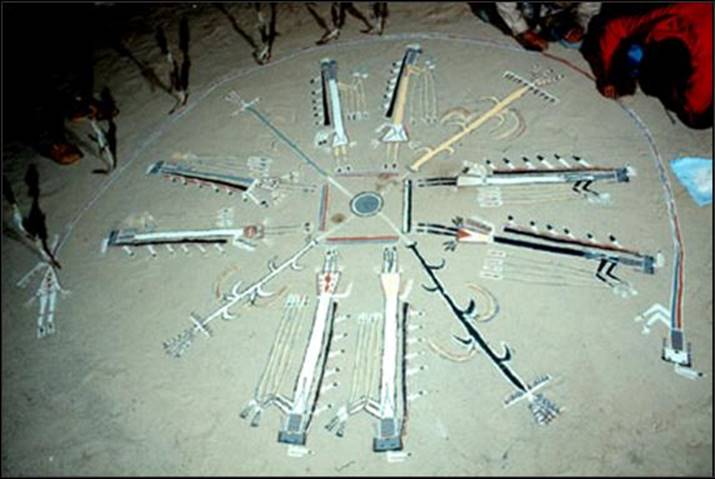
The Rainbow-person is the last to be
finished.
shape -- no particular
reason could be given for this change. Then, the northwest maize plant is
replaced with a plant that has no maize ears. It represents all the plants on
earth that provide prosperity for the animal peoples.
No
sandpainting is considered finished until at least thirteen Standing-up
Prayersticks (k'eet'áán ndii'á) are stuck into the sand to
surround the Rainbow-person who in turn encircles the miniature Coyote World.
At the western end of the sandpainting the number includes two smaller Talking
Prayersticks (k'eet'áán yáłti'ii). "All Standing-up
Prayersticks do indeed talk," the singer explained, "it is only that
additionally these two are named so." Below the two Talking Prayersticks a
tool is deposited -- a badger foot, bound together with other unnamed items
from the Blessingway ceremonial. This tool is later used for erasing the
sandpainting. Then, below the last Standing-up Prayerstick, nearest to the
Rainbow-person's head, kétłoh bowl and zaa'nił shell
are placed in readiness. A bundle of cedar twigs is added for use by the yé'ii-impersonator.
When all these things are properly placed, and when the prayersticks can be
seen in their standing-up prayer posture, the Sandpainting Ceremony has
actually begun.
;;;;;Page 140
|
|
On the seventh morning... the
blue hole of emergence is given a rectangular shape...
the northwest maize plant is
replaced with a plant that has no ears.
|
|
No sandpainting is considered
finished until at least thirteen Standing-up Prayersticks
are stuck in the sand....
;;;;;Page 141
|
|
Below the two Talking
Prayersticks a tool is deposited -- a badger foot.
|
|
...kétłoh bowl and zaa'nit shell
are placed in readiness.
;;;;;Page 142
THE CEREMONY
Compared
with the length of time it takes to prepare the sandpainting, the duration of
the yé'ii ceremony seems rather short. Everything is finished
by the time the singer has chanted three songs. But, regardless of the brief
time needed, this ceremony is pregnant with meaning. So, for instance, what the
practitioner has given to the patient during the first four days, the kétłoh and zaa'nił medicines,
are now administered by no lesser being than a Coyote Girl from the underworld
-- impersonated by a white-painted and blue-masked man. The ceremony is
performed identically on the fifth, sixth, and seventh mornings of the
ceremonial. Photographs in this report are from the first and second
performances.
The
ceremony begins when the practitioner places Standing-up Prayersticks in a
circle. With these the microcosm of the sandpainting is sanctified and
surrounded by a wall of prayer power. After kétłoh bowl, zaa'nił shell,
and badger foot are in their proper places, the singer sprinkles pollen -- first
on the hole of emergence, then on the figures in the east, then on those in the
west, next on those in the south, and finally on those in the north. Even the
small rainbows around the central hole receive his attention. At last the
all-surrounding rainbow is blessed from feet to head. Then, from a basket held
by the patient, the singer sprinkles cornmeal -- on all the sandpainting
figures in the same sequence as with pollen. The patient, who is to be
initiated, repeats the meal sprinkling after the example of his tutor.
These
procedures endow the sandpainting with power of life. The sacred microcosm
radiates its divine life essence and unites surface-world with underworld. Like
attracts like, and before long a masked Coyote-person from the underworld
appears.
The
practitioner, however, rather than singing a song about a Coyote Girl's ascent
to the surface-world -- as would seem proper -- sings about the original shaman's descent and
arrival in the underworld of the Coyote People. This can only mean that
presently this ceremony is being reenacted also in the underworld -- or at
least, that we relive here the original underworld ceremony. Whether we are
ready for it or not, as participants in this ceremony we are all invited to
"come down" with the original shaman, and with the patient, to the
source of Coyote power;
86, 95,101. Song, Fifth
Through Eighth Mornings
From
the Hogans I came down, from the Hogans I came down,
From the Hogans I came down, from the
Hogans I came down.
;;;;;Page 143
|
|
...the singer sprinkles
pollen -- first the hole of emergence, then the figures in the east...
|
|
Even the small rainbows
around the central hole receive his attention.
;;;;;Page 144
|
|
|
|
|
|
|
|
|
Then, from a basket held by the patient, the singer
sprinkles cornmeal.
|
|
Like attracts like, and before long a
masked Coyote-person from the underworld appears.
;;;;;Page
145
From beneath the Two Rising I came down, through the bushes I came
down.
In the Hogan of White Coyote I came down, through the bushes I came down.
On the White Medicine I came down, through the bushes I came down.
On the Path of Cornpollen I came down, through the bushes I came down.
On the Path of Rainbow I came down, through the bushes I came down.
On the Path of Tobacco I came down, through the bushes I came down.
On the Path of Corn-ripener Boy I came down, through the bushes I came down.
From the Hogans I came down, from the Hogans I came down,
From the Hogans I came down, from the Hogans I came down.
From beneath the Two Setting I came down, through the bushes I came down.
In the Hogan of Yellow Coyote I came down, through the bushes I came
down.
On the Yellow Medicine I came down, through the bushes I came down.
On the Path of Cornpollen I came down, through the bushes I came down.
On the Path of Sunshine I came down, through the bushes I came down.
On the Path of Corn I came down, through the bushes I came down.
On the Path of Yellow Tobacco I came down, through the bushes I came down.
From the Hogans I came down, from the Hogans I came down,
From the Hogans I came down, from the Hogans I came down.
From beneath the Two I came down, through the bushes I came down.
In the Hogan of Blue Coyote I came down, through the bushes I came down.
On the Blue Medicine I came down, through the bushes I came down.
On the Path of Pollen I came down, through the bushes I came down.
On the Path of Sunshine I came down, through the bushes I came down.
On the Path of Tobacco I came down, through the bushes I came down.
;;;;;Page 146
On the Path of Rain I came down, through the bushes I came down.
From the Hogans I came down, from the Hogans I came down,
From the Hogans I came down, from the Hogans I came down.
From beneath Where the Stars Turn I came down, through the bushes I came
down.
In the Hogan of Black Coyote I came down, through the bushes I came down,
On the Black Medicine I came down, through the bushes I came down.
On the Path of Pollen I came down, through the bushes I came down.
On the Roots of Rain I came down, through the bushes I came down.
On the Path of Corn I came down, through the bushes I came down.
On the Path of Corn-ripener Girl I came down, through the bushes I came down.
From the Hogans I came down, from the Hogans I came down,
From the Hogans I came down, from the Hogans I came down.
In
the course of this song the masked Coyote impersonator appears. Straightway he
goes to the kétłoh bowl and the zaa'nił shell.
He takes the cedar twigs, dips them into both containers and sprinkles these
medicines on the figures in the sandpainting. Sprinkling in the same east,
west, south, north sequence, he endorses what the practitioner and his
apprentice have done earlier. Each yé'ii figure in the
sandpainting receives special attention -- first the lead-yé'ii, then
the follower -ye 'ii, and then the maize plant of like color.
After sprinkling he walks away with a howl:

Now
the patient enters the sacred microcosm. He sits on the western half of the
sandpainting, facing the hole of emergence. Through this opening, everyone
knows, the first human inhabitants have come into the surface-world. Through
this same hole the first shamanic hero has gone down into the underworld to
visit the holy Coyote People. Coyote power is communicated to men through the
;;;;;Page 147
|
|
|
|
|
He takes the cedar
twigs, dips them into both containers and sprinkles
these
medicines on the figures in the sandpainting.
|
|
Each yé'ii figure
in the sandpainting receives special attention…
;;;;;Page 148
|
|
After sprinkling he walks
away with a howl.
|
|
The Coyote-person
reappears and presents the patient with kétłoh...
first to
drink...
;;;;;Page
149
same orifice through
which -- to say it in the most personal manner -- Mother Earth has given birth
to them. Healing and
initiation in Coyoteway implies a new birth.
The
Coyote-person reappears and presents the patient with kétłoh, rub-on
medicine -- first to drink and then to annoint the body. The patient finishes
rubbing on the medicine by himself. After this, the god gives zaa'nił, the
regular drinking medicine -- first to drink and then to rub on the body. In a
somewhat possessive gesture the Coyote deity applies this medicine to the head
of the patient. Meanwhile, to document the efficacy of the Coyote medicines,
the singer is chanting the story of the herbs from which these medicines are
made;
87, 96, 102. Song, Fifth through Eighth Mornings
From the hidden Hogan I came with herbs,
From the hidden Hogan I came with herbs,
From the hidden Hogan I came with herbs,
From the hidden Hogan I came with herbs.
Beneath the Two Rising I came with herbs.
In the Hogan of White Coyote I came with herbs.
On the White Medicine I came with herbs....
(continued
after the pattern of Song 86)
While
this song is still in progress, the god returns with his cedar twigs. He dips
into the feet of the yé'ii figures in the eastern portion of
the sandpainting, also into the roots of the maize plants. With the rough twigs
he rubs the essences from the divine sandy feet onto the feet of the patient.
The god subsequently repeats this action with yé'ii feet
essences from the west, south, and north of the sandpainting. The same harsh
cedar twig treatment is repeated in three more rounds -- for body, breast, and
head. After each such application the god moves away from the patient in a
sweeping motion; he exchanges the illness for divine essences and throws it far
away. With each such throwaway motion the Coyote-god howls a "wu wu wu wu
whoooo!" In conclusion of this procedure, and as a final act of taking
possession, the deity howls at close range into each of the patient's ears. For
some hours after this ceremony the patient remains silent. He seems visibly
shaken.
Before
the divine Coyote leaves, he administers the Feather-burning Rite. He brings
the hot coal, sprinkles the feather mixture, and rubs the strong-smelling smoke
on the patient. Once more he impresses his divine seal on the soul of the
patient, by shouting into both of his ears: "Wu wu wu wu whoooo!
Wu wu wu wu whoooo!" Then he goes outside.
;;;;;Page 150
|
|
The patient finishes
rubbing on the kétłoh medicine by himself.
|
|
After this, the god
gives zaa'nił, the regular drinking medicine.
;;;;;Page 151
|
|
In a somewhat possessive
gesture the Coyote deity applies this
medicine to the head
of the patient.
|
|
He dips into the feet
of the yé'ii figures in the eastern portion of the
sandpainting....
;;;;;Page 152
|
|
...he exchanges the illness
for divine essences and throws it tar away.
|
|
…as a final act of taking
possession, the deity howls at close range
into each of the patient's
ears.
;;;;;Page 153
|
|
He brings the hot coal,
sprinkles the feather mixture, and rubs the
strong-smelling smoke on
the patient.
Shortly
thereafter the yé'ii-impersonator reenters the hogan without
wearing his mask. He quietly sits down in a corner as an ordinary spectator. It
is obvious that the real god has left and is now speeding away outside. And
with this god all the Holy People represented in the sandpainting are beginning
their departure. After a brief break the patient leaves the sandpainting and
goes outside.
;;;;;Page 154
With the god being gone, the singer assumes
active leadership in the ritual. Sending home the Holy People from the east, he
stoops down to wipe out with his badger foot the white lead-yé'ii figure,
the follower-yé'ii figure, and then the figure of white maize. All
the while he besings their departure;
88, 97, 103. Song, Fifth Through Eighth Mornings
Beneath the Two Rising, he ran.
With Early Morning, Boy, he ran.
With Cornpollen for feet, he ran.
With the White Prayerstick for his hand, he ran.
With Early Morning for his feather, he ran.
With the Medicine in his hand, he ran.
With Happiness before him, he ran.
With Happiness behind him, he ran.
With Morning Dawn, he ran.
|
|
Sending home the Holy People
from the east, he stoops down.
;;;;;Page 155
|
|
Then the singer moves on to
send home the gods of the west.
Then the singer moves on to send home the gods of the west. He
wipes out their figures and sings the second stanza:
Beneath the Two Setting, he ran.
With Yellow Twilight Girl, he ran.
With Cornpollen for feet, he ran,
With the Yellow Prayerstick for his hand, he ran.
With Evening Twilight for his feather, he ran.
With Yellow Air breathing from his mouth, he ran.
With Happiness behind him, he ran.
With Happiness before him, he ran.
With Evening Twilight, he ran.
;;;;;Page 156
|
|
|
|
|
Next he removes the
pictorial presences of the gods of the south.
Next
he removes the pictorial presences of the gods of the south. He sings the third
stanza:
Beneath the Two Above, he ran.
With the Sunlight Boy, he ran.
With Cornpollen for his feet, he ran.
With the Blue Pray erstick for his hand, he ran.
With Midday Sunlight for his feather, he ran.
With the Medicine in his hand, he ran.
With Happiness before him, he ran.
With Happiness behind him, he ran.
With Midday Sunlight, he ran.
;;;;;Page 157
Finally
he turns to the north and sends away the holy Coyote People of the underworld's
north. As he wipes away their sandy representations he sings the fourth
stanza:
Beneath Where the Stars Turn, he ran.
With the Darkness Girl, he ran.
With Cornpollen for his feet, he ran.
With the Black Prayerstick for his hand, he ran.
With Darkness for his feather, he ran.
With Night-air breathing from his mouth, he ran.
With Happiness behind him, he ran.
With Happiness before him, he ran.
With Darkness, he ran.
|
|
Finally he turns to the north
and sends away the holy
Coyote
People of the underworld's north.
;;;;;Page 158
Before
the last stanza ends, the priest has taken out the emergence hole with its
surrounding rainbows, he has also sent away the outer rainbow. Last of all, he
gathers up the Standing-up Prayersticks -- their prayers are spoken. This
concludes the ceremony. While the patient still waits in the distance, two
helpers enter and skim the colored sands from the top of the ruined
sandpainting. All of it is scooped into a blanket and carried outside. The
agents of illness that have been absorbed by these materials are so dumped in a
remote place.
|
|
Last of all, he gathers up
the Standing-up Prayersticks -- their prayers are spoken.
